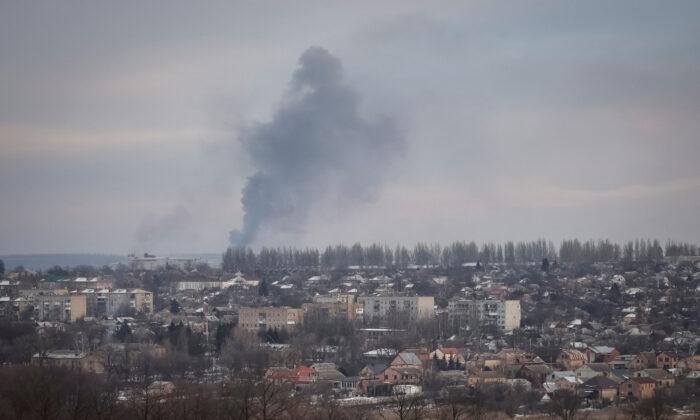KYIV—Russian missiles hit power facilities on Friday across Ukraine, where President Volodymyr Zelenskyy returned from a tour of Western capitals and Ukrainian officials said a long-awaited Russian offensive was underway in the east.
Ukraine’s armed forces said in an evening update that Russian forces fired more than 100 missiles throughout the country and staged 12 air and 20 shelling attacks. The Facebook post said 61 cruise missiles were destroyed.
Energy Minister German Galushchenko said Russia had hit power facilities in six regions with missiles and drones, causing blackouts across most of Ukraine.
In Washington, the White House said President Joe Biden would travel to Poland from Feb. 20–22 to show support for Kyiv ahead of the first anniversary of Russia’s invasion on Feb. 24 and make clear additional security assistance and aid will be coming from the United States.
“The president will make it very clear that the United States will continue to stand with Ukraine for as long as it takes,” said John Kirby, spokesperson for the White House National Security Council.
Global ratings agency Moody’s on Friday downgraded Ukraine’s sovereign rating to Ca as it expects the war with Russia to create long-lasting challenges for the country. Moody’s website said the rating means debt obligations are “likely in, or very near, default.”
The latest Russian attacks came as Zelenskyy ended a tour of European allies where he was enthusiastically received but secured no public promises of the fighter jets he sought.
“London, Paris, Brussels—everywhere I spoke these past few days about how to strengthen our soldiers. There are very important understandings and we received good signals,” he said in his nightly video address.
“This concerns long-range missiles and tanks and the next level of our cooperation—fighter aircraft.”
Russia has repeatedly attacked civilian infrastructure far from the front lines, leaving millions of Ukrainians without power, heat, or water for days at a time in the middle of winter.
The barrages have often followed Ukrainian diplomatic or battlefield advances.
Kyiv Mayor Vitali Klitschko said 10 Russian missiles had been shot down over the capital after sirens blared during the morning rush hour and weary civilians took shelter.
Ukrainian Prime Minister Denys Shmyhal said Ukraine was without 44 percent of nuclear generation and 75 percent of thermal power capacity.
“This is a deliberate targeting of infrastructure that keeps Ukrainians alive in winter,” U.S. State Department deputy spokesperson Vedant Patel said. Russia denies targeting civilians and says it targets Kyiv’s war effort.
Ukraine has been bracing for a new Russian offensive, believing that after months of reverses President Vladimir Putin wants to tout a battlefield success before the anniversary of his Feb. 24 invasion. Ukrainian governors in the eastern regions of Donetsk and Luhansk said that thrust had begun.
Putin will give his delayed annual showcase address to parliament on Feb. 21, the date last year when he recognized as independent the parts of Donetsk and Luhansk that were controlled by Russian-backed separatists, a prelude to invading.
Russian Advances
Moscow’s main recent focus has been Bakhmut, a small city from which most of the pre-war population of around 70,000 has fled, and the Ukranian military said it and surrounding areas had come under fresh tank, mortar, and artillery fire.After months of static artillery battles both sides call the “meat grinder,” Russian forces have begun to encircle the city. Their troops include the Wagner private army that has recruited tens of thousands of convicts with a promise of pardons.
Russia’s regular army is now also able to deploy many of the 300,000 or more men enlisted in a forced mobilisation late last year.
Britain’s Defense Ministry said Wagner forces appeared to have advanced 2 to 3 kilometres (1 to 2 miles) around the north of Bakhmut since Tuesday—a rapid push in a battle where front lines have barely moved for months.
It said they were now threatening the main western access road to Bakhmut although a Ukrainian military analyst said supplies were still getting through.
Britain also said Russian forces had made some advances near Vuhledar, a Ukrainian-held bastion that has been a linchpin between the southern and eastern fronts, but the limited Russian gains there had likely come at a high cost, including at least 30 armoured vehicles abandoned in one failed assault.
Ukrainian positions in Vuhledar have held since the war started and this week’s assault has been branded as a costly fiasco by some pro-war Russian military bloggers. Grey Zone, a semi-official Wagner channel on Telegram, said “a disaster is unfolding around Vuhledar, and it is unfolding again and again.”
Reuters could not verify the battlefield reports.
Ukraine plans its own major military counteroffensive in the coming months to reclaim more of the nearly one fifth of Ukrainian territory that Russia occupies.
But it appears likely to wait until it has received at least some of the new weapons, including hundreds of battle tanks and armoured vehicles, promised lately by the West.





